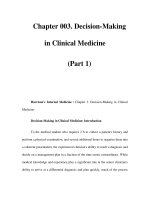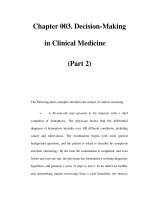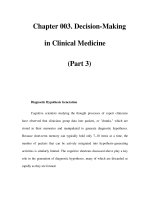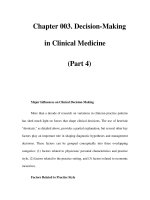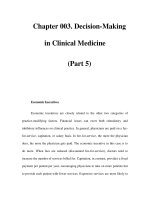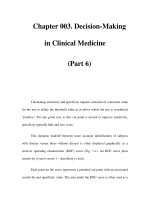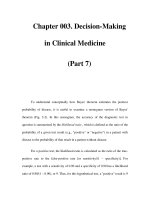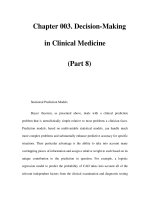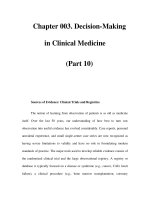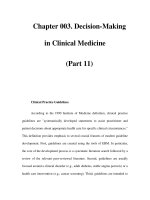Chapter 003. Decision-Making in Clinical Medicine (Part 5) pptx
Bạn đang xem bản rút gọn của tài liệu. Xem và tải ngay bản đầy đủ của tài liệu tại đây (15.48 KB, 5 trang )
Chapter 003. Decision-Making
in Clinical Medicine
(Part 5)
Economic Incentives
Economic incentives are closely related to the other two categories of
practice-modifying factors. Financial issues can exert both stimulatory and
inhibitory influences on clinical practice. In general, physicians are paid on a fee-
for-service, capitation, or salary basis. In fee-for-service, the more the physician
does, the more the physician gets paid. The economic incentive in this case is to
do more. When fees are reduced (discounted fee-for-service), doctors tend to
increase the number of services billed for. Capitation, in contrast, provides a fixed
payment per patient per year, encouraging physicians to take on more patients but
to provide each patient with fewer services. Expensive services are more likely to
be affected by this type of incentive than inexpensive preventive services. Salary
compensation plans pay physicians the same regardless of the amount of clinical
work performed. The incentive here is to see fewer patients.
In summary, expert clinical decision-making can be appreciated as a
complex interplay between cognitive devices used to simplify large amounts of
complex information interacting with physician biases reflecting education,
training, and experience, all of which are shaped by powerful, sometimes perverse,
external forces. In the next section, a set of statistical tools and concepts that can
assist in making clinical decisions in the presence of uncertainty are reviewed.
Quantitative Methods to Aid Clinical Decision-Making
The process of medical decision-making can be divided into two parts: (1)
defining the available courses of action and estimating the likely outcomes with
each, and (2) assessing the desirability of the outcomes. The former task involves
integrating key information about the patient along with relevant evidence from
the medical literature to create the structure of a decision. The remainder of this
chapter will review some quantitative tools available to assist the clinician in these
activities.
Quantitative Medical Predictions
Diagnostic Testing: Measures of Test Accuracy
The purpose of performing a test on a patient is to reduce uncertainty about
the patient's diagnosis or prognosis and to aid the clinician in making management
decisions. Although diagnostic tests are commonly thought of as laboratory tests
(e.g., measurement of serum amylase level) or procedures (e.g., colonoscopy or
bronchoscopy), any technology that changes our understanding of the patient's
problem qualifies as a diagnostic test. Thus, even the history and physical
examination can be considered a form of diagnostic test. In clinical medicine, it is
common to reduce the results of a test to a dichotomous outcome, such as positive
or negative, normal or abnormal. In many cases, this simplification results in the
waste of useful information. However, such simplification makes it easier to
demonstrate some of the quantitative ways in which test data can be used.
The accuracy of diagnostic tests is defined in relation to an accepted "gold
standard," which is presumed to reflect the true state of the patient (Table 3-1). To
define the diagnostic performance of a new test, an appropriate population must be
identified (ideally patients in whom the new test would be used) and both the new
and the gold standard tests are applied to all subjects. The results of the two tests
are then compared. The sensitivity or true-positive rate of the new test is the
proportion of patients with disease (defined by the gold standard) who have a
positive (new) test. This measure reflects how well the test identifies patients with
disease. The proportion of patients with disease who have a negative test is the
false-negative rate and is calculated as 1 – sensitivity. The proportion of patients
without disease who have a negative test is the specificity or true-negative rate.
This measure reflects how well the test correctly identifies patients without
disease. The proportion of patients without disease who have a positive test is the
false-positive rate, calculated as 1 – specificity. A perfect test would have a
sensitivity of 100% and a specificity of 100% and would completely separate
patients with disease from those without it.
Table 3-1 Measures of Diagnostic Test Accuracy
Disease Status
Test Result
Present Absent
Positive True-positive (TP) False-positive (FP)
Negative False-negative (FN)
True-negative (TN)
Identification of Patients with Disease
True-positive rate (sensitivity) = TP/(TP+FN)
False-negative rate = FN/(TP+FN)
True-positive rate = 1 – false-negative rate
Identification of Patients without Disease
True-negative rate (specificity) = TN/(TN+FP)
False-positive rate = FP/(TN+FP)
True-negative rate = 1 – false-positive rate
